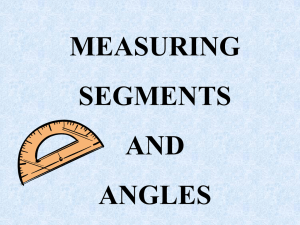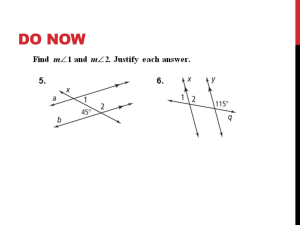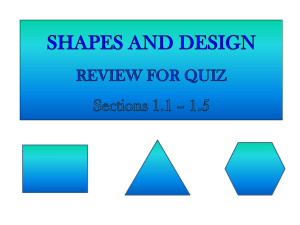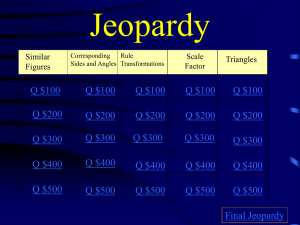if-then statement
advertisement
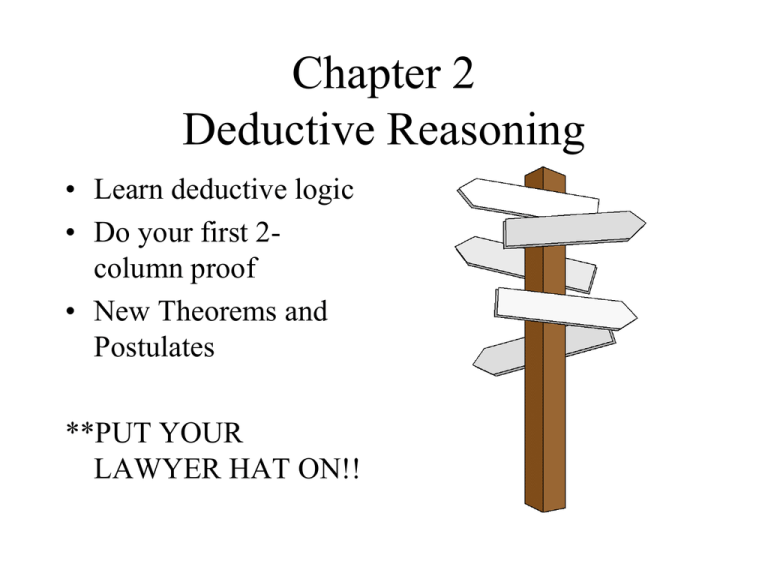
Chapter 2 Deductive Reasoning • Learn deductive logic • Do your first 2column proof • New Theorems and Postulates **PUT YOUR LAWYER HAT ON!! 2.1 If – Then Statements Objectives • Recognize the hypothesis and conclusion of an ifthen statement • State the converse of an if-then statement • Use a counterexample • Understand if and only if The If-Then Statement Conditional:is a two part statement with an actual or implied if-then. If p, then q. p ---> q hypothesis conclusion If the sun is shining, then it is daytime. • Circle the hypothesis and underline the conclusion If a = b, then a + c = b + c All theorems, postulates, and definitions are conditional statements!! Hidden If-Thens A conditional may not contain either if or then! Two intersecting lines are contained in exactly one plane. Which is the hypothesis? two lines intersect Which is the conclusion? exactly one plane contains them The whole thing: If two lines intersect, then exactly one plane contains them. (Theorem 1 – 3) The Converse A conditional with the hypothesis and conclusion reversed. Original: If the sun is shining, then it is daytime. If q, then p. q ---> p hypothesis conclusion If it is daytime, then the sun is shining. **BE AWARE, THE CONVERSE IS NOT ALWAYS TRUE!! The Counterexample • An if –then statement is false if an example can be found for which the hypothesis is true and the conclusion is false. • The example is called the Counterexample. • *Like a lawyer providing an alibi for his client… The Counterexample If p, then q FALSE TRUE **You need only a single counterexample to prove a statement false. The Counterexample If x > 5, then x = 6. x could be equal to 5.5 or 7 etc… If x = 5, then 4x = 20 always true, no counterexample **Definitions, Theorems and postulates have no counterexample. Otherwise they would not be true. To be true, it must always be true, with no exceptions. Other Forms • • • • If p, then q p implies q p only if q q if p Conditional statements are not always written with the “if” clause first. All of these conditionals mean the same thing. What do you notice? The Biconditional If a conditional and its converse are the same (both true) then it is a biconditional and can use the “if and only if” language. Statement: If m1 = 90, then 1 is a right angle. Converse: If 1 is a right angle, then m1 = 90. m1 = 90 if and only if 1 is a right angle. 1 is a right angle if and only if m1 = 90 . White Board Practice • Circle the hypothesis and underline the conclusion VW = XY implies VW XY • Circle the hypothesis and underline the conclusion VW = XY implies VW XY Write the converse of each statement • If I play football, then I am an athlete • If I am an athlete, then I play football • If 2x = 4, then x = 2 • If x = 2, then 2x = 4 • Provide a counterexample to show that each statement is false. If a line lies in a vertical plane, then the line is vertical • Circle the hypothesis and underline the conclusion K is the midpoint of JL only if JK = KL • Circle the hypothesis and underline the conclusion K is the midpoint of JL only if JK = KL • Provide a counterexample to show that each statement is false. If a number is divisible by 4, then it is divisible by 6. • Circle the hypothesis and underline the conclusion n > 8 only if n is greater than 7 • Circle the hypothesis and underline the conclusion n > 8 only if n is greater than 7 • Circle the hypothesis and underline the conclusion I’ll dive if you dive • Circle the hypothesis and underline the conclusion I’ll dive if you dive • Provide a counterexample to show that each statement is false. If x2 = 49, then x = 7. • Circle the hypothesis and underline the conclusion r + n = s + n if r = s • Circle the hypothesis and underline the conclusion r + n = s + n if r = s • Provide a counterexample to show that each statement is false. If AB BC, then B is the midpoint of AC. 2.2 Properties from Algebra Objectives • Do your first proof • Use the properties of algebra and the properties of congruence in proofs Properties from Algebra • see properties on page 37 • Read the first paragraph • This lesson reviews the algebraic properties of equality that will be used to write proofs and solve problems. • We treat the properties of Algebra like postulates – Meaning we assume them to be true Properties of Equality Numbers, variables, lengths, and angle measures WHAT I DO TO ONE SIDE OF THE EQUATION, I MUST DO … Addition Property if x = y, then x + z = y + z. Add prop of = Subtraction Property if x = y, then x – z = y – z. Subtr. Prop of = Multiplication Property if x = y, then xz = yz. Multp. Prop of = Division Property if x = y, and z ≠ 0, then x/z = y/z. Div. Prop of = Substitution if x = y, then either x or y may be Substitution substituted for the other in any equation. Property Reflexive Property x = x. A number equals itself. Reflexive Prop. Symmetric Property if x = y, then y = x. Order of equality does not matter. Symmetric Prop. Transitive Property if x = y and y = z, then x = z. Two numbers equal to the same number are equal to each other. Transitive Pop. Your First Proof Given: 3x + 7 - 8x = 22 Prove: x = - 3 (specifics) (general rules) STATEMENTS 1. 2. 3. 4. 3x + 7 - 8x = 22 -5x + 7 = 22 -5x = 15 x=-3 REASONS 1. 2. 3. 4. Given Substitution Subtraction Prop. = Division Prop. = Properties of Congruence Segments, angles and polygons Reflexive Property AB ≅ AB A segment (or angle) is congruent to itself Reflex. Prop Symmetric If AB ≅ CD, then CD ≅ AB Property Order of equality does not matter. Symm. Prop Transitive If AB ≅ CD and CD ≅ EF, then AB ≅ EF Property Two segments (or angles) congruent to the same segment (or angle) are congruent to each other. Trans. Prop Your Second Proof A B Given: AB = CD Prove: AC = BD STATEMENTS 1. 2. 3. 4. AB = CD BC = BC AB + BC = BC + CD AB + BC = AC BC + CD = BD 5. AC = BD C D REASONS 1. Given 2. Reflexive prop. 3. Addition Prop. = 4. Segment Addition Post. 5. Substitution 2.3 Proving Theorems Objectives • Use the Midpoint Theorem and the Bisector Theorem • Know the kinds of reasons that can be used in proofs PB & J Sandwich • How do I make one? – Pretend as if I have never made a PB & J sandwich. Not only have I never made one, I have never seen one or heard about a sandwich for that matter. – Write out detailed instructions in full sentences – I will collect this First, open the bread package by untwisting the twist tie. Take out two slices of bread set one of these pieces aside. Set the other in front of you on a plate and remove the lid from the container with the peanut butter in it. Take the knife, place it in the container of peanut butter, and with the knife, remove approximately a tablespoon of peanut butter. The amount is not terribly relevant, as long as it does not fall off the knife. Take the knife with the peanut butter on it and spread it on the slice of bread you have in front of you. Repeat until the bread is reasonably covered on one side with peanut butter. At this point, you should wipe excess peanut butter on the inside rim of the peanut butter jar and set the knife on the counter. Replace the lid on the peanut butter jar and set it aside. Take the jar of jelly and repeat the process for peanut butter. As soon as you have finished this, take the slice of bread that you set aside earlier and place it on the slice with the peanut butter and jelly on it, so that the peanut butter and jelly is reasonably well contained within. The Midpoint Theorem If M is the midpoint of AB, then AM = ½ AB and MB = ½ AB A M B The Midpoint Theorem If M is the midpoint of AB, then AM = ½ AB and MB = ½ AB • How is the definition of a midpoint different from this theorem? – One talks about congruent segments – One talks about something being half of something else • How do you know which one to use in a proof? Important Notes • Does the order matter? • Don’t leave out steps Don’t Assume Given: M is the midpoint of AB Prove: AM = ½ AB and MB = ½ AB A Statements (specifics) 1. 2. 3. 4. M is the midpoint of AB AM MB or AM = MB AM + MB = AB AM + AM = AB Or 2 AM = AB 5. AM = ½ AB 6. MB = ½ AB M B Reasons (general rules) 1. 2. 3. 4. Given Definition of a midpoint Segment Addition Postulate Substitution Property 5. Division Property of Equality 6. Substitution The Angle Bisector Theorem If BX is the bisector of ABC, then m ABX = ½ m ABC A m XBC = ½ m ABC X B C A Given: BX is the bisector of ABC Prove: m ABX = ½ m ABC m XBC = ½ m ABC X B 1. BX is the bisector of ABC; 1. 2. m ABX = m XBC 2. or ABX m XBC 3.m ABX + m XBC = m ABC 3. 4.m ABX + m ABX = m ABC 4. or 2 m ABX = m ABC 5. m ABX = ½ m ABC 5. 6. m XBC = ½ m ABC 6. C Given Definition of Angle Bisector Angle Addition Postulate Substitution Division Property of = Substitution Property Reasons Used in Proofs (pg. 45) • • • • • Given Information Definitions (bi-conditional) Postulates Properties of equality and congruence Theorems How to write a proof (The magical steps) • Use these steps every time you have to do a proof in class, for homework, on a test, etc. Example 1 Given : m 1 = m 2; AD bisects CAB; BD bisects CBA Prove: m 3 = m 4 D 1 A C 2 3 4 B 1. Copy down the problem. • Write down the given and prove statements and draw the picture. Do this every single time, I don’t care that it is the same picture, or that the picture is in the book. – Draw big pictures – Use straight lines 2. Mark on the picture • Read the given information and, if possible, make some kind of marking on the picture. • Remember if the given information doesn’t exactly say something, then you must think of a valid reason why you can make the mark on the picture. • Use different colors when you are marking on the picture. 3. Look at the picture • This is where it is really important to know your postulates and theorems. Look for information that is FREE, but be careful not to Assume anything. – – – – Angle or Segment Addition Postulate Vertical angles Shared sides or angles Parallel line theorems 4. Brain. • Do you have one? • I mean have you drawn a brain and are you writing down your thought process? Every single time you make any mark on the picture, you should have a specific reason why you can make this mark. If you can do this, then when you fill the brain the proof is practically done. 5. Finally look at what you are trying to prove • Ask yourself: “Does it make sense?” “why?” • Write out a plan to help organize your thoughts • Then try to work backwards and fill in any missing links in your brain. Think about how you can get that final statement. 6. Write the proof. • (This should be the easy part) Statements 1. 2. 3. 4. Etc… Reasons 1. 2. 3. 4. Etc… Example 1 Given : m 1 = m 2; AD bisects CAB; BD bisects CBA Prove: m 3 = m 4 D 1 A C 2 3 4 B Statements Reasons 1. m 1 = m 2; AD bisects CAB; BD bisects CBA 1. Given 2. m 1 = m 3; m 2 = m 4 3. m 3 = m 4 2. Def of bisector 3. Substitution Try it Given : WX = YZ Y is the midpoint of XZ Prove: WX = XY W X Y Z Statements Reasons 1. WX = YZ Y is the midpoint of XZ 2. XY = YZ 1. Given 3. WX = XY 3. Substitution 2. Def of midpoint QUIZ REVIEW • • • • • Underline the hypothesis and conclusion in each statement Write a converse of each statement and tell whether it is true or false Provide a counter example to show that the statement is false Be able to complete a proof Name the reasons used in a proof (there are 5) 2.4 Special Pairs of Angles Objectives • Apply the definitions of complimentary and supplementary angles • State and apply the theorem about vertical angles Complimentary & Supplementary angles • Rules that apply to either type.. 1. We are always referring to a pair of angles (2 angles) .. No more no less 2. Angles DO NOT have to be adjacent 3. **Do not get confused with the angle addition postulate Complimentary Angles Any two angles whose measures add up to 90. If mABC + m SXT = 90, then ABC and SXT are complimentary. S A ABC is the complement of SXT B SXT is the complement of ABC C X T Supplementary Angles Any two angles whose measures sum to 180. If mABC + m SXT = 180, then ABC and SXT are supplementary. S A ABC is the supplement of SXT SXT is the supplement of ABC C B X T Vertical Angles Two angles formed on the opposite sides of the intersection of two lines. 1 4 2 3 Vertical Angles Two angles formed on the opposite sides of the intersection of two lines. 1 4 2 3 Vertical Angles Two angles formed on the opposite sides of the intersection of two lines. 1 4 2 3 The only thing the definition does is identify what vertical angles are… NEVER USE THE DEFINITION IN A PROOF!!! **THIS THEOREM WILL BE USED IN YOUR PROOFS OVER AND OVER Theorem Vertical angles are congruent (The definition of Vert. angles does not tell us anything about congruency… this theorem proves that they are.) 1 4 2 3 Remote Time True or False • m A + m B + m C = 180, then , B, and C are supplementary. True or False • Vertical angles have the same measure True or False • If 1 and 2 are vertical angles, m 1 = 2x+18, and m 2 = 3x+4, then x = 14. A- Sometimes B – Always C - Never • Vertical angles ____________ have a common vertex. A- Sometimes B – Always C - Never • Two right angles are ____________ complementary. A- Sometimes B – Always C - Never • Right angles are ___________ vertical angles. A- Sometimes B – Always C - Never • Angles A, B, and C are __________ complementary. A- Sometimes B – Always C - Never • Vertical angles ___________ have a common supplement. White Board Practice • Find the measure of a complement and a supplement of T. m T = 40 White Board Practice • Find the measure of a complement and a supplement of T. m T = 89 White Board Practice • Find the measure of a complement and a supplement of T. mT=a White Board Practice • A supplement of an angle is three times as large as a complement of the angle. Find the measure of the angle. • Let x = the measure of the angle. • 180 – x : This is the supplement • 90 – x : This is the complement 180 – x = 3 (90 – x) 180 – x = 270 – 3x 2x = 90 x = 45 2.5 Perpendicular Lines Objectives • Recognize perpendicular lines • Use the theorems about perpendicular lines Perpendicular Lines () Two lines that intersect to form right angles. If l m, then the l angles are right. If the angles are right, then l m. m Perpendicular Lines () • Two lines that form one right angle form four right angles • You can conclude that two lines are perpendicular by definition, once you know that any of the angles they form is a right angle • The definition applies to intersecting rays and segments • The definition can be used in two ways (biconditional) – PG. 56 Theorem If two lines are perpendicular, then they form congruent, adjacent angles. l If l m, then 1 2. 1 2 m PARTNERS: Complete the proof on page 57 problem #1 Theorem If two lines intersect to form congruent, adjacent angles, then the lines are perpendicular. l If 1 2, then l m. 1 2 m Partners THINK – PAIR – SHARE • Discuss the wording of Theorems 2 – 4 and 2 – 5. • Look at the hypothesis and conclusion of each • When would you use each in a proof? Theorem If the exterior sides of two adjacent angles lie on perpendicular lines, then the angles are complimentary. l If l m, then 1 and 2 are compl. 1 2 m CAN ANYONE EXPLAIN? PARTNERS • Answer questions 6-10 on page 57 • #6 – Def. of perp. lines • #7 – Def. of perp. Lines • #8 – If 2 lines are perp., then they form cong. Adj. angles • #9 – Def. of perp. Lines • #10 – IF 2 lines form cong. Adj. angles, then the lines are perp. Construction 4 Given a segment, construct the perpendicular bisector of the segment. Given: AB Construct: bisector of Steps: AB Construction 5 Given a point on a line, construct the perpendicular to the line through the point. Given: line l with point A Construct: to l through A Steps: Construction 6 Given a point outside a line, construct the perpendicular to the line through the point. Given: line l with point A Construct: to l through A Steps: 2.6 Planning a Proof Objectives • Discover the steps used to plan a proof Remember Magical Proof Steps Demo • Complimentary and supplementary Theorems • I need 4 Volunteers Theorem If two angles are supplementary to congruent angles (or the same angle) then they are congruent. If 1 suppl 2 and 2 suppl 3, then 1 3. 1 2 3 Theorem If two angles are complimentary to congruent angles (or to the same angle) then they are congruent. If 1 compl 2 and 2 compl 3, then 1 3. 1 2 3 Practice • Given: 2 and 3 are supplementary Prove: m 1 = m 3 1 2 3 4 Statements Reasons 1. L2 and L3 are supp. 1. Given 2. mL2 +m L1 = 180 2. angle addition postulate 3. L2 is supp. to L1 3. Def of supp. angles 4. mL1 = mL3 4.If two angles are supp. to the same angle, then the two angles are congruent Practice • Given: m 1 = m 4 Prove: 4 is supplementary to 2 1 2 3 4 Statements Reasons 1. mL1 = m L4 1. Given 2. mL2 +m L1 = 180 2. angle addition postulate 3. L2 is supp. to L1 3. Def of supp. angles 4. L4 is supp. to L2 4.Substituion Test Review • Underline the hypothesis and conclusion in each statement • Write a converse of each statement and tell whether it is true or false • Fill in the blanks of an algebraic proof and a geometric proof • Name the following – Complementary / supplementary angles – Perpendicular lines or rays – Vertical angles • Understand what you can deduce from a diagram that is marked • Right angles = 90 / Straight angles that = 180 • Using vertical angles to find measures • Setting up an algebraic problem of = angles in order to solve for a variable – then using the variable to solve the measure of other angles • **SHOWING YOUR WORK IN THE ANSWER DOCUMENT WHEN SOLVING FOR A VARIABLE OR MEASUREMENT** • Setting up and solving an equation involving a supplement and complement of an angle • Complete an entire geometric proof
